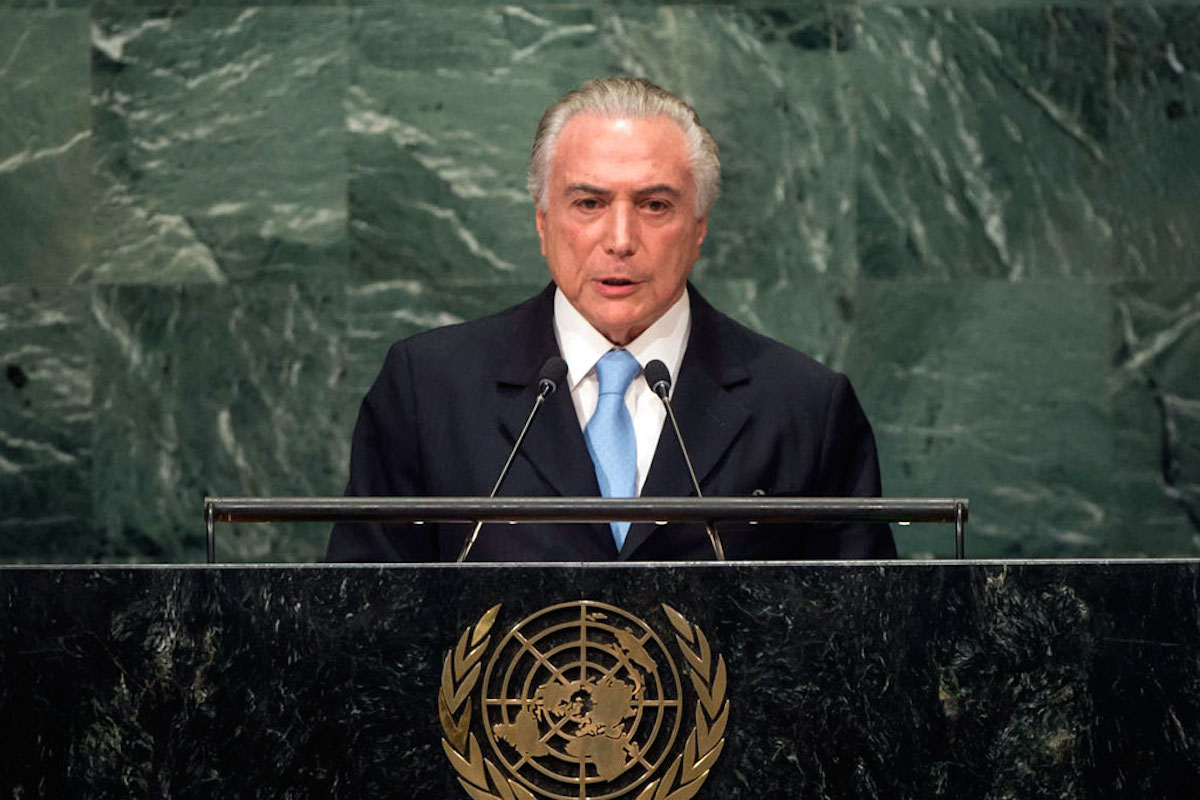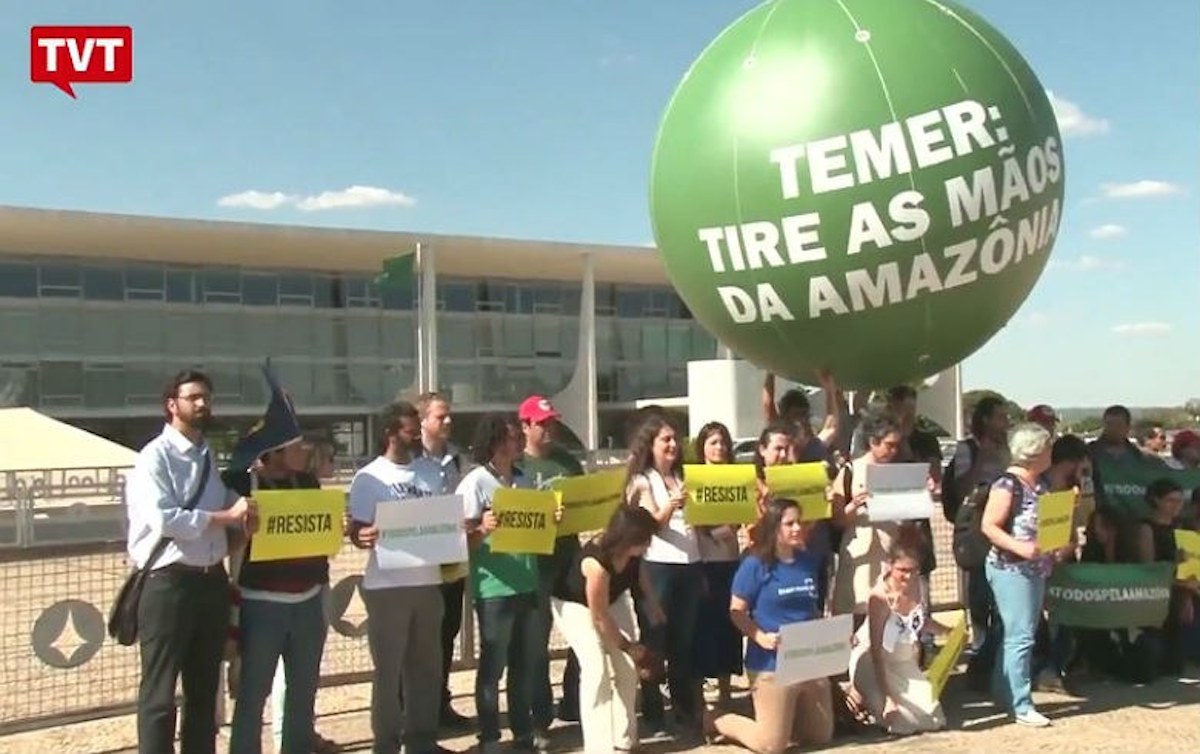- In his speech to the 72nd General Assembly of the United Nations in New York on Monday, Brazil’s president Michel Temer referred to preliminary data showing reduced deforestation that critics say may not be accurate.
- Critics also refute other aspects of his speech, including his touting of Brazil’s renewable energy movement. Hydropower is the country’s largest source of renewable energy, which scientists say can have a huge carbon footprint.
- A protest comprised of representatives from more than 150 organizations gathered in Brasilia on Tuesday in reaction to Temer’s speech.
Representatives of more than 150 civil society organizations gathered in Brasilia on Tuesday (19 September) to protest over the speech made by Brazilian president Michel Temer on Monday (18 September) at the opening of 72nd General Assembly of the United Nations in New York.
In his speech, Temer said: “Deforestation is a question that worries us, especially in Amazonia. We have concentrated attention and resources on this question and I now bring you the good news that the first available figures [for this year] indicate a fall of over 20 percent in deforestation in [Amazonia].”
Temer’s speech appears to have been intended to re-assure the international community, which has strongly criticized the environmental and indigenous policies of his administration over the past few months.
“We have returned to the good path and we will continue along this path,” Temer told the Assembly.

Brazil
In June, Norway gave a stern warning to Temer on his visit to Oslo that Brazil could lose millions of dollars from the Amazon Fund if Brazil’s deforestation continued to rise. In August, the outcry after Temer signed a presidential decree to abolish a gigantic national reserve in the Amazon was so great that Temer had to issue a second decree, clarifying the first. Eventually, a federal judge annulled both decrees.
In his address, Temer also stressed Brazil’s contribution to combatting global warming. “My country – and it is with great satisfaction that I say this – is in the vanguard of the global movement towards a low carbon economy. Clean and renewable energy represents more than 40 percent of our energy grid – three times the world average.”
However, many environmentalists and political activists reacted to Temer’s speech with criticism. During Tuesday’s demonstration in Brasilia, organizations issued a press release in which they said that the socio-environmental advances made by Brazil in recent decades had been “summarily dismantled” by the Temer government.
The release then carried a long list of “retrogressive” initiatives by the Temer government, including “the abolition of protected areas or a reduction in their size, a paralysis in the demarcation of the land belonging to indigenous communities, quilombolas [communities set up by people formerly held in slavery] and agrarian reform, a weakening in environmental legislation, sale of land to foreigners, an amnesty for environmental crimes and debts of agribusiness, the legalization of land theft.”
Temer’s claim that deforestation is falling in Amazonia is based on data recently published by the non-governmental research institute, Imazon. These figures showed a 21 percent reduction in deforestation between August 2016 and July 2017, compared with the previous year.
Normally, the government disregards figures published by Imazon, relying on official data issued by INPE (the National Institute of Space Research) but INPE has not yet published figures for this year. Last year INPE’s data showed a 29 percent increase in deforestation, compared with the previous year, with the destruction of 7,989 square kilometers (3,084 square miles) of forest between August 2015 and July 2016.
This marked a sharp increase over the low deforestation rates seen four and five years earlier, though well below the 26,832 square kilometers (10,360 square miles) INPE data indicate were cleared in 2004.
Imazon, itself, is unhappy with the way its figures were used by President Temer. “The data that Imazon publishes monthly can indicate a tendency and so it is possible that deforestation falls,” forest engineer Paulo Barreto, linked to Imazon, told BBC Brasil. “But we can’t say ‘by over 20%’ because we don’t have the precise figures that such a statement requires.”
Barreto was also critical of the way Temer attributed the putative decline in deforestation to government policies. “Various policies contribute to deforestation, from public policies to the economy and the market,” he said. “There is a historic relation between the price of cattle and deforestation rates. An increase in price increases deforestation, and vice-versa. And [Brazil’s] economic crisis has been generating a fall in price.”

Imazon’s latest bullet also contained a warning, not mentioned by Temer: over the last year 20 percent of all deforestation in Amazonia occurred in protected areas – forests, national parks, and biological reserves – created to form barriers to deforestation. According to Imazon, many people invading these areas are getting their cue from Brasilia, where moves are under way in Congress to have their illegal occupations legalized.
Temer is not the first Brazilian president to express pride in the share of renewables in Brazil’s energy grid. Figures published earlier this year showed that 43 percent of the country’s energy came from renewable sources in 2016. Of this, the lion’s share came from hydropower, which provided 82 percent, followed by biomass (9 percent) and wind (5 percent).
However, even here Temer’s statement is not uncontroversial.
Some scientists, like Philip Fearnside, have long questioned the idea that Brazil’s tropical dams are “clean” emissions-free energy sources. Early this year a broader study, looking at 267 reservoirs across six continents, calculated that they contributed 1.3 percent of human-made greenhouse gas emissions. For many, this raises the question as to whether hydropower should still be seen as a “green” power.
Temer is in New York at the head of a large delegation, including six ministers and the presidents of large state bodies, like the oil company Petrobras, the National Economic and Social Development Bank (BNDES) and the Central Bank. One of the main events took place on Wednesday morning at a seminar organized by the Financial Times when the government spoke about its planned economic reforms and announced a package of privatizations.
No mention was made of the ongoing investigations into corruption, with yet another accusation of corruption made this week against the president by the Office of the Attorney-General, or of the results of a recent poll that suggest that the president’s popularity has fallen to just 3.4 percent of the electorate.
FEEDBACK: Use this form to send a message to the editor of this post. If you want to post a public comment, you can do that at the bottom of the page.